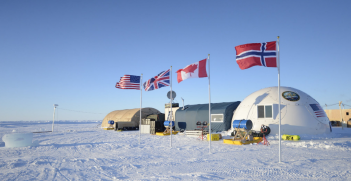The Rules-Based Order Applying to Antarctica

Governance of Antarctica is an outstanding example of the application of a rules-based order. It has shown itself to be robust, flexible and capable of meeting emerging challenges.
The Antarctic Treaty was concluded in Washington on 1 December 1959. Only 19 months later, on 23 June 1961, it came into force. The Treaty formed the basis for what eventually became known as the Antarctic Treaty System (ATS) which included several later-negotiated legal instruments.
When this thickening body of law and institutional development is combined with other bodies of international law that apply in the region, especially those found in the 1982 UN Convention on the Law of the Sea, it becomes apparent that there is a distinctive rules-based order governing Antarctica and the Southern Ocean.
The operation of these legal instruments constitutes a solid establishment of rules governing Antarctica and regulating activities affecting its environment. Over the years Australia has made a very significant contribution to the negotiation and application of these Antarctic rules. In addressing future challenges, Australia is well placed to respond creatively, as it has over the last 60 years, with Australia likely to continue playing a leading role in formulating and gaining acceptance of proposed solutions.
Creation of the 1961 Antarctic Treaty
One of the prime motivations for negotiating the Antarctic Treaty was security. The 1950s was a decade of considerable tension regarding Antarctica. Seven territorial claims had been made to parts of the continent, including the largest – 42 per cent — by Australia, but those claims were not widely recognised. The Antarctic Peninsula was particularly contested with overlapping claims made by Argentina, Chile and the United Kingdom. The two Cold War protagonists – the USSR and the USA – had a significant physical presence on the continent, and had reserved their rights to possible territorial claims.
It was therefore remarkable that at the end of the 1950s –the height of the Cold War era — it proved possible to conclude an Antarctic Treaty, which inter alia stipulated the demilitarisation of the continent, the creation of the world’s first nuclear weapons-free zone, the putting aside of sovereignty disputes, the protection of scientific research and the use of Antarctica solely for peaceful purposes. In effect, a new security construct for Antarctica was created in the form of a legally binding treaty.
Challenges to the Treaty
In its first 57 years of operation, the Treaty has survived at least two major political challenges and has emerged the stronger for having done so. The first came in 1983 when the UN General Assembly considered arguments by a group of Asian and Third World States that the Treaty was a relic of a colonialist mindset. Led by Malaysia, the draft UN Resolution aimed to draw on elements of the 1982 Law of the Sea Convention and the 1979 Moon Treaty by arguing that Antarctica should be managed by the UN as the “common heritage of mankind”. The Treaty parties responded constructively and unanimously, insisting that nations had only to accede to the Treaty if they wished to participate in Antarctic affairs.
The second major challenge was precipitated by the oil crisis of the 1970s when Antarctica became regarded as a possible source of fossil fuels. The number of states acceding to the Treaty increased and in 1988 the Treaty parties agreed to adopt the Convention on the Regulation of Antarctic Mineral Resource Activities. However, led by Australia and France and influenced by a range of environmental campaigners, the Treaty Parties decided instead to adopt the Protocol on Environmental Protection to the Antarctic Treaty (the Madrid Protocol) which declared a 50-year ban on mining in Antarctica and established binding measures for environmental protection. The negotiation of the Madrid Protocol represented a dramatic shift from an exploitation view to a protection view of dealing with Antarctic resources. It was also seen by many as an impressive measure of Australian influence on Antarctic politics, and indeed of Australian foreign policy prowess.
The ability of the system to overcome these challenges is testament to its strength. A key reason for the success of the system is that decisions under the Treaty are reached by consensus. The Antarctic Treaty itself also provided for a possible review conference to be held once it had been enforced for thirty years, being 1991. The fact that there was no call for a review conference suggests that parties are accepting current arrangements and are unlikely to challenge the consensus that they represent.
As to future challenges, there has in recent years been speculation in academic presentations and by the media that the mining prohibition contained in the Madrid Protocol may be under threat. The argument for making this case is somewhat overdrawn. Parties with active Antarctic programs are parties to the Protocol and are therefore committed to the mining prohibition. This commitment was recently confirmed by all Treaty parties, and there is no suggestion that any other countries are interested in exploiting Antarctic minerals. The constraints on doing so would be formidable, since the Protocol also sets out conditions which must be met before the mining prohibition can be removed. The prohibition can be amended only by the unanimous agreement of the 1991 Consultative Parties which is highly unlikely. Challenges like these are bound to emerge from time to time, but the Antarctic Treaty Parties’ capacity to deal with them successfully has been well demonstrated.
The governance of the Australian Antarctic Territory, and Australia’s broader interests in Antarctica, are overwhelmingly affected by international and domestic law. In particular, since 1961, the Antarctic Treaty and its associated Treaties has provided the basis for a remarkable regime which maintains in a unique way equilibrium between the interests of Antarctic claimants and others.
Indeed, the promotion of a system of international legal instruments around the Treaty has transformed a continent essentially devoid of rules and regulations into a model of international co-operation and stewardship.
It is within this context that Australia, as both a claimant state and an active supporter of the Antarctic Treaty System, negotiates and balances its interests and frames its laws. This outstanding example of the application of a rules-based order has shown itself to be robust, flexible and capable of meeting emerging challenges. It has evolved based on co-operation and consensus decision making and Australia has been actively involved throughout.
The integrity of the system will endure in the future and continue to demonstrate resilience to address changing circumstances. Australia has strong national and international interests in ensuring that it does.
David Mason is the former Executive Director of the Treaties Secretariat at the Department of Foreign Affairs and Trade.
This article is an edited extract of his paper titled “The Rules-Based Order Applying to Antarctica and its Environment” presented at a conference on Australia and the Rules-Based International Order held on 18-19 July organised by the Australian Institute of International Affairs, Department of Foreign Affairs and Trade and ANU Coral Bell School with the support of the Attorney-General’s Department.
This article is published under a Creative Commons Licence and may be republished with attribution.





